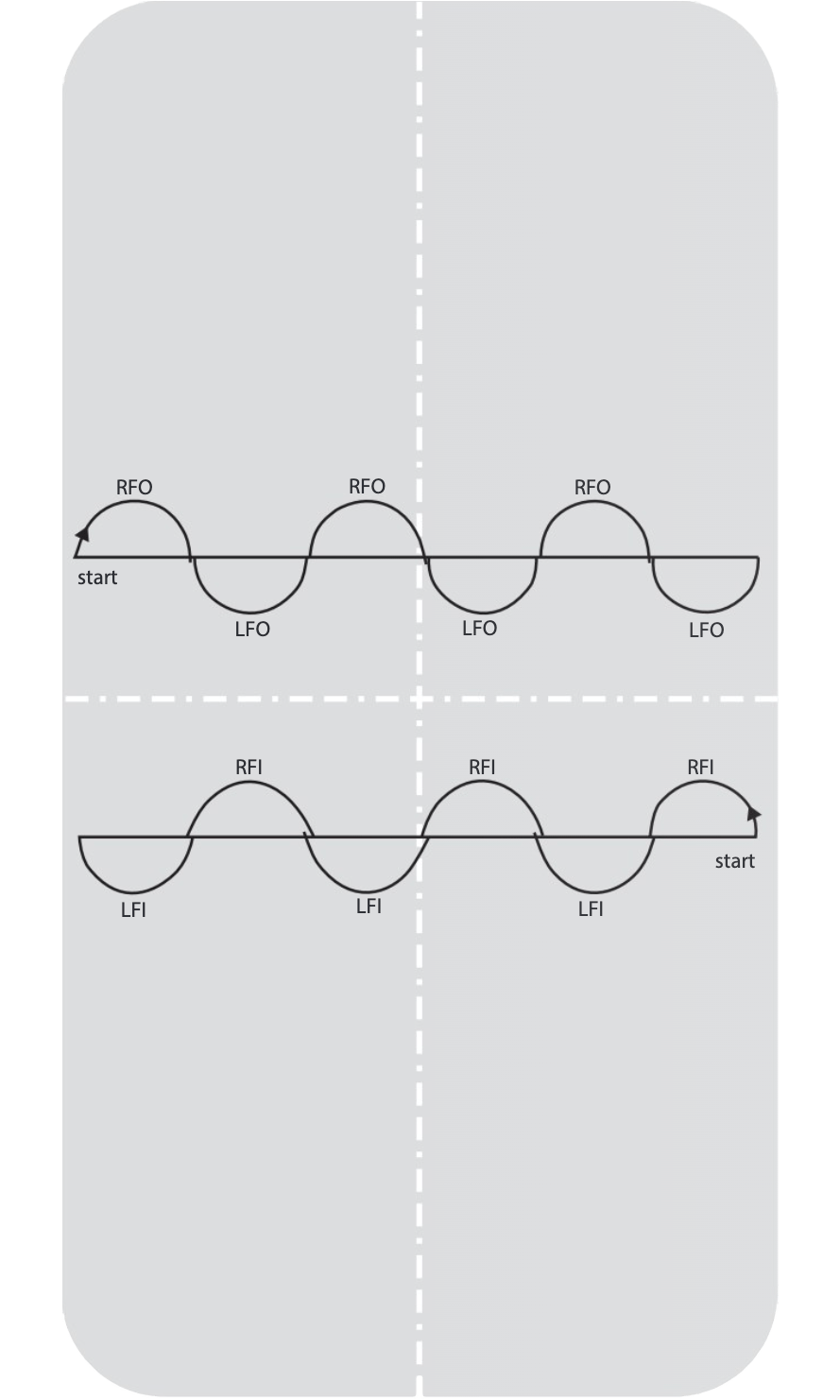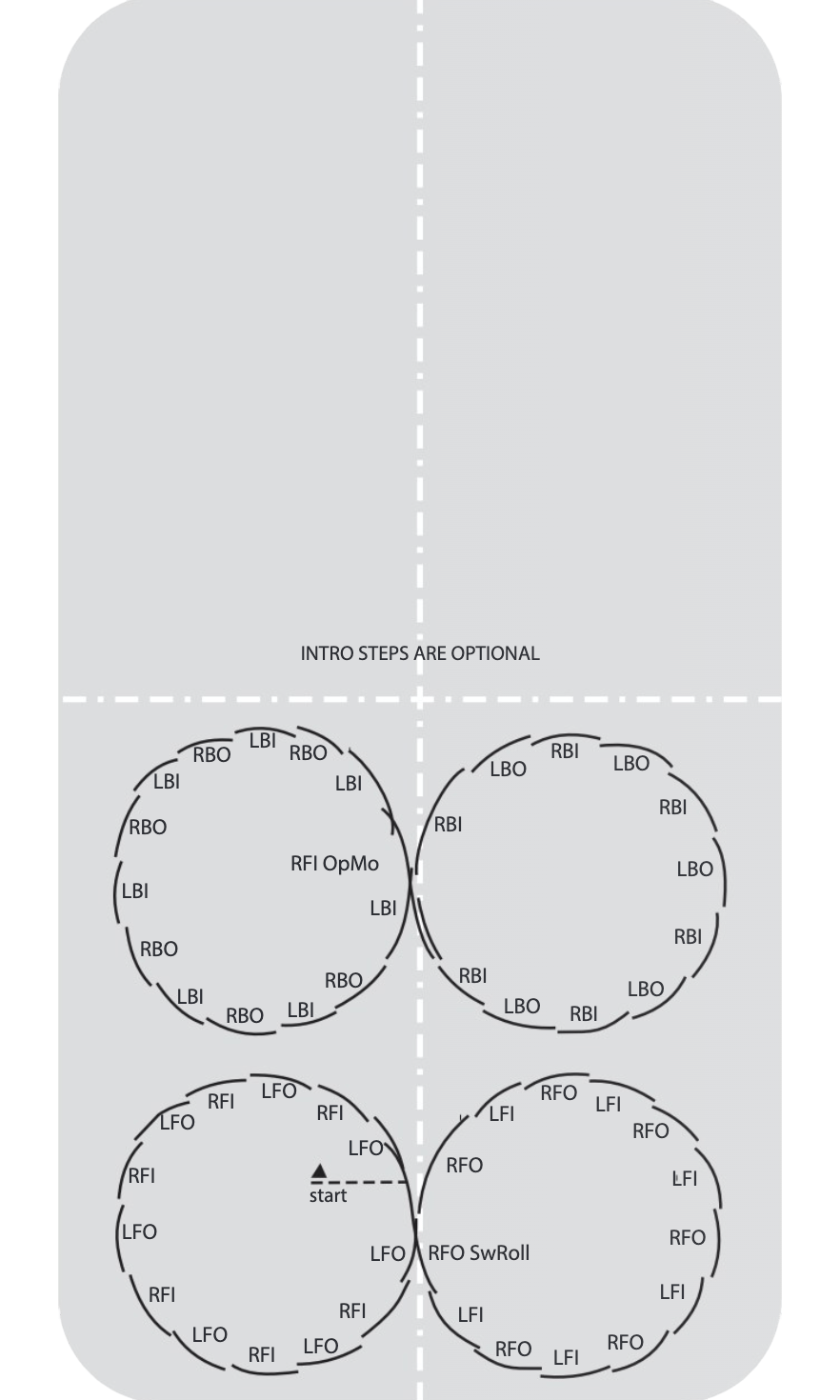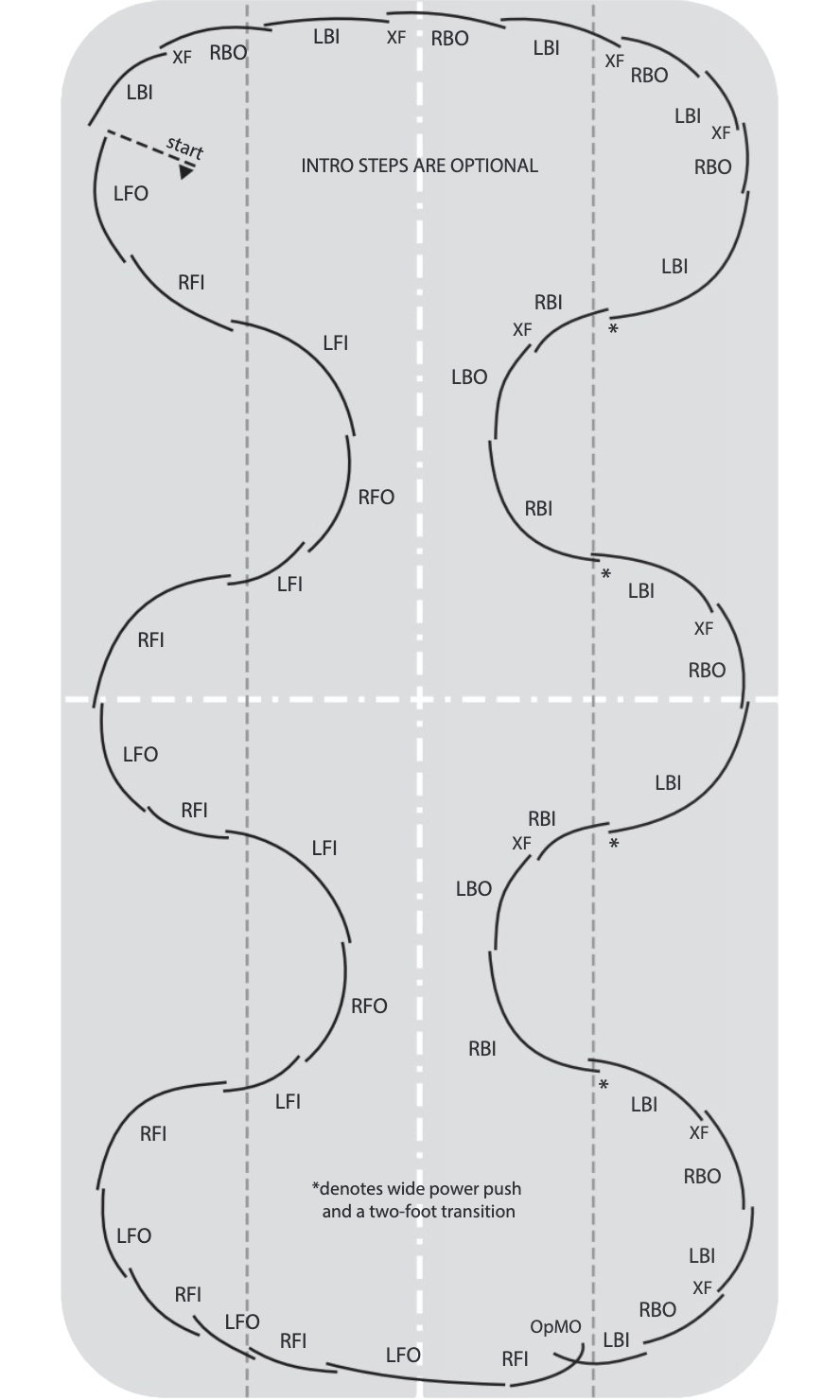Table of Contents for Adaptive Skating Moves in the Field
Adaptive Skating Pre-Bronze Moves in the Field
Forward Perimeter Stroking
The skater will perform four to eight straight strokes depending on the length of the ice and the strength of the skater, with crossovers around the ends, using the full ice surface and for one full lap of the rink (in both directions). Introductory steps are optional.
Basic Consecutive Forward Edges
• Forward outside edges
• Forward inside edges
Starting from a standing position, the skater will perform four to six half circles, alternating feet, using an axis line such as a hockey line. The skater may start each set on either foot, but they must be skated in the order listed.
Forward Crossovers
The skater will perform forward crossovers in a figure eight pattern. The transition between the two circles may be on two feet. Four to six crossovers per circle are recommended. This move may start in either direction. Introductory steps are optional.
Adaptive Skating Bronze Moves in the Field
Forward and Backward Crossovers
The skater will perform forward crossovers in a figure eight pattern. It is expected that the skater will perform the transition between circles on one foot. Four to six crossovers per circle are recommended. Upon completing the forward figure eight, the skater will perform a swing roll and change of edge to an open mohawk in order to turn around and continue the figure eight pattern with four to six backward crossovers per circle. This move may start in either direction. Introductory steps are optional.
Forward Right and Left Foot Spirals or Lunges
The skater will perform right foot and left foot spirals down the length of the rink maintaining a spiral position on each foot for approximately four seconds with extended leg held at the hip level or higher. The skater may be on flats and may start on either foot. Introductory steps are optional.
OR
The skater will perform right foot and left foot lunges down the length of the rink maintaining a lunge position on each foot for approximately four seconds. The skater may be on flats and may start on either foot. Introductory steps are optional.
Basic Consecutive Backward Edges
• Backward outside edges
• Backward inside edges
Starting from a standing position, the skater will perform four to six half circles, alternating feet, using an axis line such as a hockey line. The skater may start each set on either foot, but they must be skated in the order listed.
Alternating Forward Three-Turns
Starting from a standing position the skater will perform alternating forward outside three-turns for the width of the rink. The skater will then perform forward inside alternating three-turns for the second width of the rink. The size of the rink and strength of the skater will determine the number of three-turns skated. This move may start on either foot.
Adaptive Skating Silver Moves in the Field
Forward and Backward Perimeter Power Stroking
The skater will perform four alternating forward crossovers separated by strong forward inside edge transitions. The end pattern consists of two forward crossovers followed by a LFO open stroke; then a RFI open mohawk followed by one or two backward crossovers. All end pattern steps should be performed with an even cadence except the LFO open stroke, which should be held for two counts. The second side of the pattern resumes with four backward crossovers separated by two-foot transitions, also known as a power push. Skaters should take care to perform the transitions on two solid inside edges. The second end pattern consists of three to five backward crossovers. Introductory steps are optional.
Five-Step Mohawk Sequence
The skater will perform alternating forward inside mohawks, skated in consecutive half circles. Each series consists of a five-step sequence. The skater will skate one length of the ice with four or five lobes. Introductory steps are optional.
Forward Circle Eight
The skater will push from a standing start onto a forward outside edge and complete one forward outside figure eight. Upon returning to center at the completion of the second circle, the skater will perform a forward inside figure eight by pushing onto a forward inside edge, thereby repeating the previously skated circle. The circles should be equal in size with each circle approximately three times the skater’s height. The skater may mark the center. This move may start on either foot.
Circular Sequence
The skater will perform a left forward crossover, to a left forward outside edge, to a right forward inside mohawk, to a right back crossover, to a right forward inside edge. The step sequence must be repeated twice and performed left and right. Introductory steps are optional. This move may start in either direction.
Waltz Three-Step Sequence
The skater will perform this move in a figure eight pattern. A two-step introduction may be added. The skater will perform a right forward outside three-turn to a left back outside edge, to a right forward outside three-turn to a left back outside edge, to a right forward outside three-turn to a left back outside edge, to a step forward to right forward outside edge and glide on two feet back to center. The skater will then perform a left forward outside three-turn to a right back outside edge, to a left forward outside three turn to a right back outside edge, to a left forward outside three-turn to a right back outside edge, to a step forward to a left forward outside edge and glide on two feet back to center. Aminimum of three, three-turn/back edge sequences per circle must be performed.
Adaptive Skating Gold Moves in the Field
Eight-Step Mohawk Sequence
The skater will perform two eight-step mohawk sequences counterclockwise. The step order is: Forward crossover into a left forward outside mohawk, followed by left back inside, right back outside, left back inside cross forward and right forward inside. The skater should maintain a march cadence (one beat per step). Between the circles is a two-beat left foot transition. The sequence is then repeated twice in the opposite direction. Introductory steps are optional. This move may start on either foot.
Forward and Backward Free Skate Cross Strokes
The skater will perform free skate cross strokes the length of the ice surface. Forward cross strokes will be skated for one length of the rink and backward cross strokes skated for the second length of the rink. Introductory steps and end patterns are optional. This move may start on either foot.
Alternating Right Forward Changes of Edge and Left Forward Three-Turns
The skater will perform a right forward outside to inside change of edge into left forward inside three-turn, followed by a right forward inside to outside change of edge into left forward outside three-turn. This move will be performed down the length of the rink, in sequence. A maximum of four introductory steps may be used.
Alternating Left Forward Changes of Edge and Right Forward Three-Turns
The skater will perform a left forward outside to inside change of edge into right forward inside three-turn, followed by a left forward inside to outside change of edge into right forward outside three-turn. This move will be performed down the length of the rink, in sequence. A maximum of four introductory steps may be used.
Alternating Backward Crossovers to Backward Outside Edges
The skater will perform alternating backward crossovers to backward outside edges in consecutive half circles for one length of the rink. Four or five lobes should be skated. Introductory steps are optional.
Backward Circle Eight
The skater will push from a standing start onto a backward outside edge and complete one backward outside figure eight. Upon returning to center at the completion of the second circle, the skater will perform a backward inside figure eight by pushing onto a backward inside edge, thereby repeating the previously skated circle. The circles should be equal in size with each circle approximately three times the skater’s height. The skater may mark the center. This move may start on either foot.


















